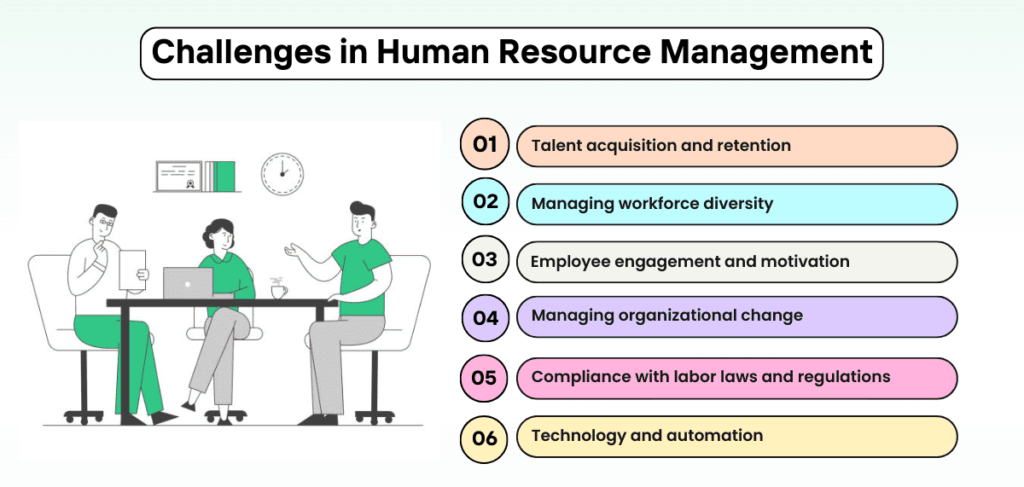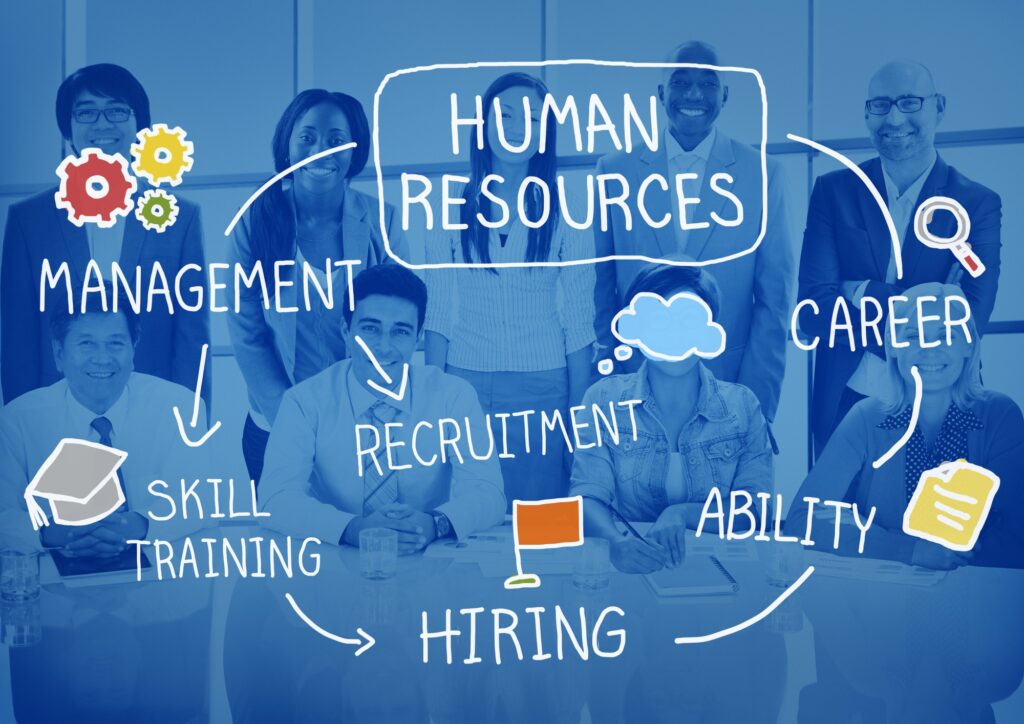Introduction
Human Resource Management (HRM) plays a crucial role in organizations by overseeing the workforce, managing employee relations, and ensuring compliance with labor laws. HR professionals face a myriad of challenges of hrm in today’s dynamic workplace, some of which may come as surprising obstacles. Let’s delve into such challenges of HRM that every HR professional should be aware of.
Table of Contents
Hidden Challenges of HRM

Employee Recruitment and Retention Challenges
- Attracting Top Talent: In today competitive job market, attracting top talent is a significant challenge for HRM professionals. The focus is not just on hiring individuals based on skills but also on cultural fit and potential for growth within the organization.
- Ensuring Diversity and Inclusion: HRM must ensure diversity and inclusion in recruitment and selection processes to create a more inclusive and innovative work environment.
- Managing High Turnover Rates: High turnover rates can be detrimental to an organization’s success, leading to increased recruitment costs and decreased morale among existing employees.
Compliance and Legal Challenges of HRM
- Keeping Up with Changing Labor Laws: HRM professionals must stay updated with changing labor laws and regulations to ensure compliance and mitigate legal risks.
- Handling Employee Relations Issues: Resolving employee relations issues, conflicts, and disputes in a fair and timely manner is essential for maintaining a positive work environment.
- Ensuring Data Privacy and Security: With the increasing focus on data privacy, HRM must take measures to protect employee data and ensure compliance with data privacy regulations.
Employee Development and Training Challenges
- Identifying Training Needs: HRM professionals must identify the training needs of employees to enhance their skills and knowledge, aligning them with organizational goals.
- Balancing Individual and Organizational Development: Striking a balance between individual career development and organizational goals is one of a common challenges of HRM professionals.
- Measuring Training Effectiveness: It is crucial to measure the effectiveness of training programs to ensure that they are providing the desired outcomes and adding value to the organization.

Employee Engagement Challenges
- Promoting Work-Life Balance: HRM plays a critical role in promoting work-life balance to prevent burnout and increase employee satisfaction and retention.
- Fostering a Positive Organizational Culture: Creating a positive organizational culture where employees feel engaged, motivated, and valued is a challenge that requires continuous effort and focus.
- Managing Remote Teams: With the rise of remote work, HRM professionals face the challenge of effectively managing and engaging remote teams to ensure productivity and collaboration.
Employee Health and Wellbeing Challenges
- Managing stress and burnout in the workplace is crucial for employee well-being.
- Addressing mental health issues among employees requires a supportive environment.
- Promoting a healthy work-life balance fosters better productivity.
Managing Diversity and Inclusion Challenges
- Creating an inclusive work environment for employees from diverse backgrounds encourages innovation.
- Handling conflicts and biases in a multicultural workforce requires sensitivity and cultural awareness.
- Implementing diversity initiatives that go beyond surface-level changes promotes a truly inclusive workplace.
Solutions to the challenges of HRM
Some of the solutions to the challenges of HRM are as follows;
Recruitment and Retention Strategies;
1. Embracing Diversity and Inclusion
- Implementing inclusive hiring practices can attract a wider pool of talent.
- Diverse teams lead to innovative solutions and better decision-making.
- Embracing fosters a culture of acceptance and respect in the workplace.
2. Leveraging Technology for Recruitment
- Utilizing AI and data analytics streamlines the recruitment process.
- Online platforms and social media expand the reach of job listings.
- Technology helps in creating a seamless candidate experience.
3. Employee Development and Training Initiatives
- Investing in employee training increases retention and engagement.
- Tailored development programs cater to individual growth needs.
- Continuous learning opportunities boost employee skill sets and morale.

Workforce Flexibility and Remote Management;
1. Implementing Flexible Work Arrangements
- Flexible work schedules enable work-life balance and productivity.
- Remote work options attract top talent from diverse locations.
- Flexibility boosts employee satisfaction and overall well-being.
2. Balancing In-Person and Remote Collaboration
- Hybrid work models foster teamwork and creativity.
- Effective communication tools bridge the gap between in-person and remote teams.
- Creating a cohesive work culture despite physical distance is key.
3. Addressing the Challenges of Remote Team Management
- Building trust and accountability in remote teams is essential.
- Setting clear expectations and goals ensures team alignment.
- Regular check-ins and feedback sessions maintain team cohesion.
Employee Well-being and Mental Health Support;
1. Prioritizing Mental Health in the Workplace
- Mental health initiatives reduce stress and burnout among employees.
- Encouraging open discussions about mental health reduces stigma.
- Employee assistance programs provide support for mental health challenges.
2. Providing Resources and Support for Employee Well-being
- Wellness programs promote physical and mental health in the workplace.
- Offering flexible work options accommodates personal well-being needs.
- Creating a supportive environment encourages work-life balance.
3. Creating a Positive Work Environment
- Recognizing and rewarding employees improves morale and motivation.
- Promoting work-life balance through policies and initiatives enhances well-being.
- Fostering a culture of respect and inclusivity boosts employee satisfaction.

Data-Driven Decision-Making in HR;
1. Utilizing HR Analytics for Strategic Planning
- Analyzing HR data improves workforce planning and resource allocation.
- Identifying trends and patterns guides strategic decision-making.
- Data-driven insights optimize recruitment, performance management, and training.
2. Interpreting Data to Inform HR Practices
- Data analysis helps in predicting future workforce needs.
- Monitoring key performance indicators enhances performance evaluations.
- Data interpretation drives improvements in employee engagement and retention.
3. Ensuring Data Privacy and Security Compliance
- Implementing robust data protection protocols safeguards employee information.
- Compliance with data privacy laws fosters trust among employees.
- Maintaining data security reduces the risk of data breaches and legal challenges.
Summary
In today’s rapidly changing business landscape, organization faces new challenges of hrm that require innovative solutions. From recruitment strategies to remote management and employee well-being, HR professionals must adapt to meet the needs of their workforce. Embracing diversity, leveraging technology, prioritizing employee well-being, and utilizing data-driven insights are crucial aspects of navigating the evolving landscape of HR.
Conclusion
HR professionals face many challenges of hrm, ranging from recruitment to diversity and well-being. By proactively addressing these challenges, organizations can create a positive work environment and foster employee engagement. The evolving role of HR professionals highlights the need for adaptability and an understanding of the diverse needs of the workforce.
FAQs
- What are the common challenges of HRM professionals?
- Common challenges of hrm include recruitment and selection, training and development, employee engagement, and legal compliance.
- How can organizations address recruitment and selection challenges effectively?
- Organizations can address these challenges by focusing on attracting top talent, promoting diversity and inclusion, and managing turnover rates.
- Why is legal compliance important in HRM practices?
- Legal compliance is crucial to protect both employees and organizations, ensuring fair treatment, ethical practices, and data privacy and security.
- How can HR professionals stay updated on changing labor laws?
- HR professionals can attend training sessions, webinars, and seminars to stay informed about evolving labor laws.
- What are some strategies for improving employee retention rates?
- Strategies like offering professional development opportunities, recognizing achievements, and fostering a positive work culture can improve employee retention rates.
- How can companies promote diversity and inclusion in the workplace?
- Companies can implement diversity training programs, establish employee resource groups, and create a culture of inclusivity to promote diversity and inclusion.